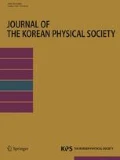Abstract
Here, we propose a model for the Drosophila chordotonal neurons where the axoneme is an actively contracting wire, regulated by the calcium ion concentration. To date, which of Nanchung-inactive and no mechanoreceptor potential C channels are transient receptor potential channels (TRP) in chordotonal sensory cilia is still not clear. Our theory explains previous experimental findings, including non-linear gating compliance and spontaneous oscillation of the antenna. It also explains that neural signaling takes place only at amplitudes of mechanical stimulation much higher than those generating active amplification, which has not been explained so far within the conventional single-type TRP channel model.
Similar content being viewed by others
References
J. Howard and A. Hudspeth, Neuron 1, 189 (1988).
B. Nadrowski, P. Martin and F. Jülicher, Proc. Natl. Acad. Sci. U.S.A. 101, 12195 (2004).
C. Köppl, G. A. Manley, A. N. Popper and R. R. Fay, Insights from Comparative Hearing Research (Springer, New York, 2014), p. 13.
A. Kamikouchi, T. Shimada and K. Ito, J. Compar. Neurology 499, 317 (2006).
J. T. Albert and M. C. Göpfert, Curr. Opinion Neurobio. 34, 79 (2015).
W. S. Lee et al., J. Korean Phys. Soc. 73, 1225 (2018).
J. Kim et al., Nature 424, 81 (2003).
Z. Gong et al., J. Neurosci. 24, 9059 (2004).
M. C. Göopfert, J. T. Albert, B. Nadrowski and A. Kamikouchi, Nat. Neurosci. 9, 999 (2006).
R. Walker, A. Willingham and C. Zuker, Science 2877, 2229 (2000).
T. Effertz et al., Nat. Neurosci. 15, 1198 (2012).
Z. Yan et al., Nature 493, 221(2013).
J. Lee, S. Moon, Y. Cha and Y. D. Chung, PLoS One 5, e11012 (2010).
D. F. Eberl, R. W. Hardy and M. J. Kernan, J. Neurosci. 20, 5981 (2000).
D. Zanini and M. C. Göopfert, in Mammalian Transient Receptor Potential (TRP) Cation Channels (Heidelberg: Springer, Berlin, 2014), p. 899.
T. Effertz, R. Wiek and M. C. Göpfert, Curr. Biol. 21, 592 (2011).
B. P. Lehnert et al., Neuron 77, 115 (2013).
A. Nesterov et al., Neuron 86, 665 (2015).
B. Warren and T. Matheson, J. Neurosci. 38 3741 (2018).
A. Hudspeth, Y. Choe, A. Mehta and P. Martin, Proc. Natl. Acad. Sci. U.S.A. 97, 11765 (2000).
P. G. Gillespie and R. G. Walker, Nature 413, 194 (2001).
L. H. Field and T. Matheson, In Advances in Insect Physiology (Academic Press, Amsterdam, 1998), Vol. 27, pp. 1–228.
S. H. Strogatz, Nonlinear Dynamics and Chaos: with Applications to Physics, Biology, Chemistry and Engineering (CRC Press, Boca Raton, 2018).
M. Göpfert and D. Robert, Proc. Natl. Acad. Sci. U.S.A. 100, 5514 (2003).
E. F. Smith, Molecul. Biol. Cell 13, 3303 (2002).
J. T. Albert, B. Nadrowski and M. C. Göopfert, Curr. Biol. 17, 1000 (2007).
B. Nadrowski, J. T. Albert and M. C. Göpfert, Curr. Biol. 18, 1365 (2008).
K-H. Ahn, J. Royal Soc. Interface 10, 20130525 (2013).
R. Basto and W. F. Marshall, Methods in Cilia and Flagella (Academic Press, Amsterdam, 2015), Vol. 127.
S. Karak et al., Sci. Rep. 5, 17085 (2015).
D. Zanini and M. C. Göpfert, Curr. Biol. 23, R349 (2013).
Acknowledgments
We thank Y. D. Chung, J. Lee, and D. Robert for helpful discussion. WSL and KHA were supported by a National Research Foundation of Korea (NRF) grant funded by the Korea ministry of science, ICT and future planning (NRF2017R1A2B3010002) and by Chungnam National University.
Author information
Authors and Affiliations
Corresponding author
Rights and permissions
About this article
Cite this article
Lee, W.S., Ahn, KH. Heterogeneous TRP Channel Model of a Chordotonal Neuron Might Explain Drosophila Hearing. J. Korean Phys. Soc. 76, 118–124 (2020). https://doi.org/10.3938/jkps.76.118
Received:
Revised:
Accepted:
Published:
Issue Date:
DOI: https://doi.org/10.3938/jkps.76.118




